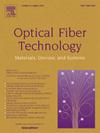Dynamic realization of miscellaneous profile services in elastic optical networks using spectrum partitioning
IF 2.6
3区 计算机科学
Q2 ENGINEERING, ELECTRICAL & ELECTRONIC
引用次数: 0
Abstract
Optical backbone networks are required to be highly adaptable in terms of bandwidth allocation, to accommodate the dynamic demands of emerging broadband wireless and fixed access networks. To address this requirement, rather than assigning a fixed bandwidth to each request, services are offered based on the requested bandwidth profile, which enables a more diverse range of services to be offered and more efficient usage of spectrum resources. To accommodate the service requests with miscellaneous bandwidth profiles, including minimum, average, and maximum spectrum slot requirements, as well as holding time, two innovative techniques have been developed. These schemes ensure that the allocated bandwidth meets the minimum requirement, does not exceed the maximum, and achieves the desired average bandwidth, considering the time-weighted average of the assigned spectrum slots over the holding period. These methods also utilize probabilistic spectrum partitioning, which enforces different probabilities to contributing spectrum partitions in a certain service realization. Employing this probabilistic spectrum partitioning along with profile-based routing, improves the chance of accommodating requests and consequently reduces request blocking probability. The results indicate that our algorithms can successfully realize the requested services by achieving a blocking probability of less than 0.07 for offered loads up to 1000 erlang, in the Deutsche Telekom network topology.
利用频谱划分在弹性光网络中动态实现各种配置文件服务
为了适应新兴宽带无线和固定接入网络的动态需求,要求光骨干网络在带宽分配方面具有很强的适应性。为满足这一要求,我们不再为每个请求分配固定的带宽,而是根据请求的带宽配置文件提供服务,这样既能提供更多样化的服务,又能更有效地利用频谱资源。为了满足各种带宽要求(包括最小、平均和最大频谱时隙要求以及保持时间)的服务请求,开发了两种创新技术。这些方案可确保分配的带宽满足最低要求,不超过最大要求,并达到所需的平均带宽,同时考虑到所分配频谱时隙在保持期内的时间加权平均值。这些方法还利用了概率频谱分区,即在实现某种服务时,对频谱分区采用不同的概率。采用这种概率频谱划分和基于配置文件的路由选择,可提高满足请求的几率,从而降低请求阻塞概率。结果表明,在德国电信网络拓扑中,我们的算法可以成功实现请求的服务,在提供高达 1000 erlang 的负载时,阻塞概率小于 0.07。
本文章由计算机程序翻译,如有差异,请以英文原文为准。
求助全文
约1分钟内获得全文
求助全文
来源期刊

Optical Fiber Technology
工程技术-电信学
CiteScore
4.80
自引率
11.10%
发文量
327
审稿时长
63 days
期刊介绍:
Innovations in optical fiber technology are revolutionizing world communications. Newly developed fiber amplifiers allow for direct transmission of high-speed signals over transcontinental distances without the need for electronic regeneration. Optical fibers find new applications in data processing. The impact of fiber materials, devices, and systems on communications in the coming decades will create an abundance of primary literature and the need for up-to-date reviews.
Optical Fiber Technology: Materials, Devices, and Systems is a new cutting-edge journal designed to fill a need in this rapidly evolving field for speedy publication of regular length papers. Both theoretical and experimental papers on fiber materials, devices, and system performance evaluation and measurements are eligible, with emphasis on practical applications.
 求助内容:
求助内容: 应助结果提醒方式:
应助结果提醒方式:


